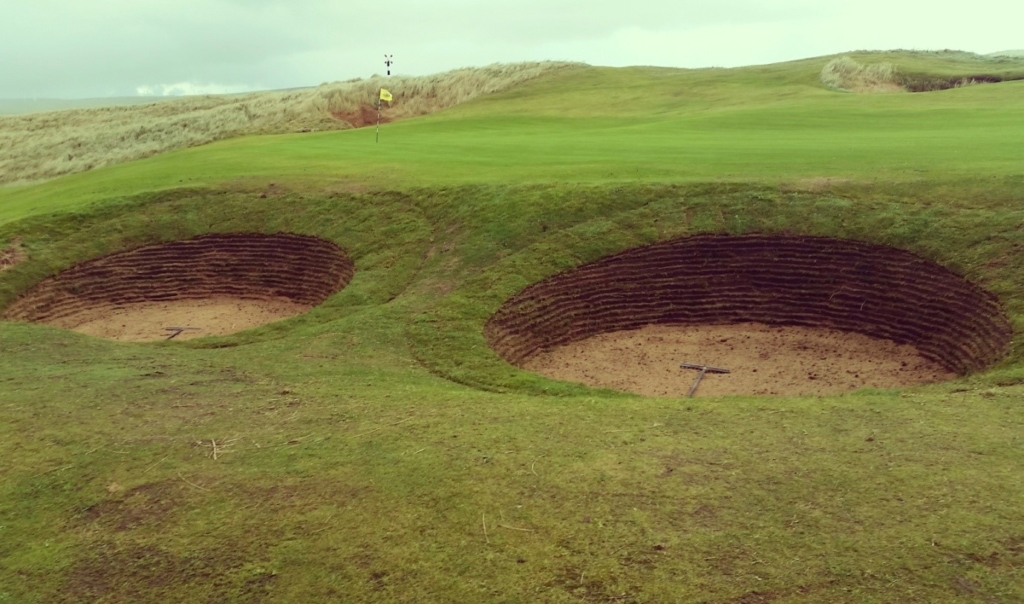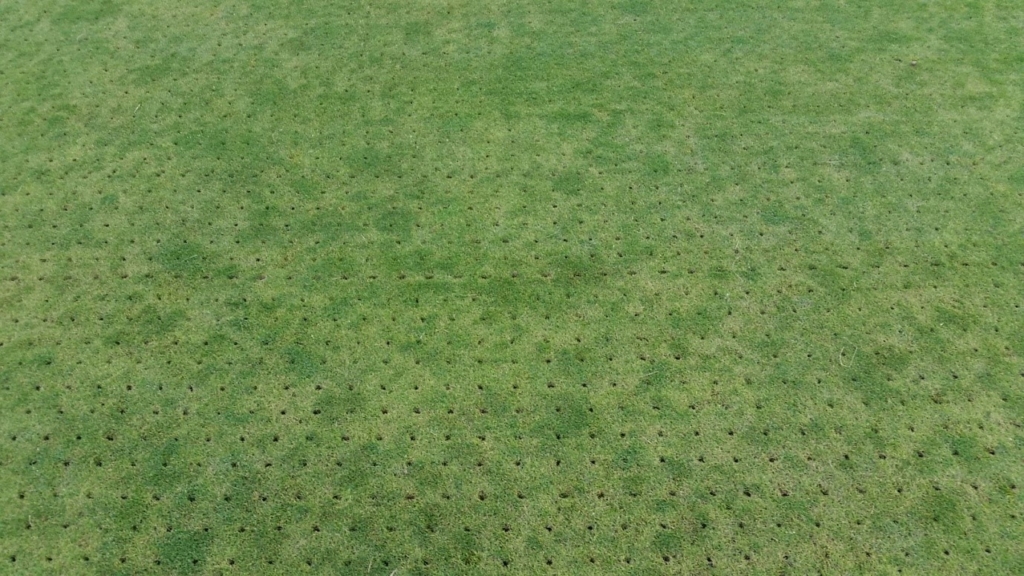Playing in the Sand and Getting Soaked on a Daily Basis
The rain that I moaned about in last month’s report carried right on into November without a second thought for the spirits of Machrihanish Dunes’ greenkeeping squad, but we chose to rise above it and carry on. We have overhauled a few more bunkers (some of which were full-scale rescue projects and were a lot of fun to engineer) and we will continue with this program until we inevitably run out of turf.

As is the norm during late autumn, our work is not all about construction, and this year we have balanced the building work with copious amounts of aeration on all playing surfaces and cutting and rolling to retain good playing conditions wherever we can. Mowing regimes have to be adapted at this time of year to suit the needs of the plant as well as the needs of the golfer, as the grass doesn’t like the poor weather and short days any more than we do. You will notice that we have backed away from our summer program of cutting tees, fairways, and roughs daily to only twice a week, and even then, at a much taller mowing height.
Why Do We Cut Greens Shorter in Summer Than We Do in Winter?
It is just one of those things that is generally accepted without question, isn’t it? Once the last competition is done and dusted, the cut height increases and the greens get hairier and slower for the winter. But why do we greenkeepers feel the need to do this? After all, temperatures in Kintyre hold up well in autumn and early winter—it is quite regularly warmer throughout November and even into December here than it is in May (when the easterly wind can tear the face right off you!). So how come it is deemed ok to cut the greens relatively short in late spring but not considered acceptable when we are going into winter? This is a sensible and well-thought-out set of questions that I was recently asked by a member, so here is the definitive answer:
Grass needs leaf cover in order to photosynthesise, and the more of the topical growth we remove by mowing the less able the plant will be to perform this life-giving function. The name “photosynthesis” describes the function of the process perfectly, as plants cleverly utilise light energy to convert carbon dioxide and water into carbohydrates and oxygen. The light from the sun’s rays is absorbed and then stored by reaction centres in the grass leaf which contains green chlorophyll pigments. The plant can use this stored light to create the carbohydrates and by-products it needs to give it the energy to grow and protect itself from physical stress.
As greenkeepers, we need to be acutely aware of two parameters when considering how to avoid compromising the efficiency of the photosynthesis process:
- We need to focus on which grass species are growing in our greens, as some species have wider leaf blades than others. A typical green at Machrihanish Dunes contains a decent percentage of:
- Fine-leaved fescue, which we hope to encourage for a number of reasons – such as playability and suitability for golf, resistance to disease, cost-effectiveness to maintain, etc.
- Annual meadow grass, which we are not so keen on, but we tolerate because we recognise that despite its shallow-rooting nature, annoying seeding habit, and its propensity to fall foul of diseases such as fusarium patch, it helps to tighten up our swards and allows less room for moss and weed ingress. It is definitely better to have any grass than no grass!
These two species grow happily alongside one another in our links environment and provide good playing characteristics, but the combination is compromised due to annual meadow grass having much thicker leaves than fescue. It can, therefore, tolerate a much lower cut height, but if we employ that mowing height, we will inevitably kill all the perennial fescue because there is far less space on its narrower leaf blades for chlorophyll reaction centres. Its leaf blades, therefore, need to be left longer so there is enough available space for chloroplasts to absorb and store enough light, allowing the plant to convert carbon dioxide and water into sufficient quantities of the carbohydrate fuel it needs to carry on its daily functions (now that was a mouthful…even for me!).
Of course, we could just give up and shave the greens down and favour the annual meadow grass, but then we would have to put up with more seasonal seeding, more disease attacks, poorer winter performance, more thatch build up–which would require more regular and more invasive aeration—and then we would find that because all the grass in our greens (instead of just a percentage of it as before) had big fat leaves, the greens would not actually turn out to run as fast as we had hoped anyway…so let’s just not even go there!
In summary, if we want our greens to play well, we need to look after the needs of the perennial fescue. To do that, we cannot afford to mow too short or we will remove too much of the plant’s surface area and reduce its ability to absorb and store sunlight in its fine leaves.
- We need to be aware of the amount of sunlight that is available to the plant. Now, this is the actual reason why the cut height goes up in the winter, and it is especially important in a place like Kintyre where temperatures remain relatively high even when the days get shorter. Because the plant is still actively growing, it needs a lot of energy to function, and as we have just discussed, it needs to get that energy from sunlight via the photosynthesis process.
This sunlight is very easy to come by in June when the midday sun is right above us and we have 20 hours of daylight at our disposal. But during an autumn like the one we are experiencing right now, this can be a tough ask because not only do the days rapidly start to get shorter and shorter, but the sun makes only fleeting appearances between the periods of relentless rain and general greyness.
The available reaction sites can only store the light that is available to them and if that cumulative energy is not enough to provide the plant with the reserves that it needs to complete its daily functions, it will literally wither and die. It makes sense then to increase the number of reaction sites wherever possible so we can increase the total amount of light energy an individual plant can store despite the limited efficiency of each reaction site. The most obvious way to do this is simply to leave the grass longer.
Amongst all the complicated chemistry and biology, effective golf course maintenance really is just a simple case of looking around us and making common-sense judgments informed by our experience of working with a specific rootzone in a specific micro-climate. In this case, we know that because of the plentiful energy supplies available to our grass in mid-summer via the photosynthesis process, we can afford to take ludicrous liberties with plant health in an attempt to produce optimum playing conditions. But when it comes to the dark, miserable, pitifully short days of winter, we need to back right off and protect our fragile environment in order to ensure that we can hit the ground running when the next spring finally arrives.

The Winter League Is in Full Swing!
The hardy souls who enjoy golf in the winter have been playing every Sunday since the middle of October, so if you do intend to make an assault on the winter league this year, you already have some catching up to do. It’s not too late though—the competition runs through to the end of March. Competitions are few and far between over the winter months, but we do still have a monthly medal (the next one will be played on December 17th) and a New Year’s Day tournament for you to participate in.
If you have any questions about the competition schedule why not pay Lorna and Peter a visit to the Golf House? The coffee is always on and we all know that a friendly welcome is guaranteed. Lorna still holds a good stock of Machrihanish Dunes merchandise at the Golf House so if you are looking for ideas for seasonal gifts you could do worse than to have a browse through the rails. There is a lot of good gear there that any family member or friend would be delighted to receive.
I’ll leave you with that shameless plug, but I look forward to seeing you on your next visit. Hopefully, the weather will take a turn for the better in the coming weeks so that you can get out and enjoy some golf and both you and the fescue can soak up some much-needed vitamin D!

